News
A suspect is seized in Kotakethana – but are there more in the woods?
Terror of a serial killer lurking in the woods of Kotakethana, Kahawatte grips local villagers despite Friday’s arrest of a man charged with the latest homicide in the death-filled area.
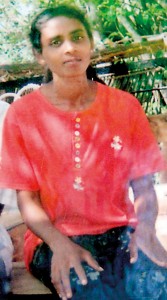
The victim: Chandrani Somalatha
Chandrani Somalatha, 39, a mother of three, went missing in the early hours of last Sunday morning (April 5). Police found her decomposing body near a stream close to her house 36 hours after she was reported missing. A post-mortem examination showed she had died from blows to the head and body from a blunt weapon.
Police on Friday arrested the woman’s 18-year-old son who lived in the house with her. The boy had confessed that he had asked his mother for money to buy a gift for his girlfriend and had killed her because she had refused to give him the funds.
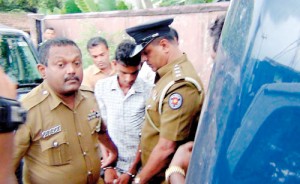
Two faces of the suspect:The victim’s son in police custody on Friday following a confession (above) and (right), earlier on in the week,the son being led by a friend to the spot where his mother’s body was found
For the police the case might be closed but for the villagers of Kotakethana this murder is reminiscent of the past where 17 other murders had taken place in the last eight years.
Although police have tried to pin the killings first on a politician and then on a deranged army deserter no substantial arrest has been made.
Residents in the area who had been lulled into believing that the serial killer stalking the area had been somehow apprehended and punished are now again fearful. Questions are once more being raised about the veracity of police claims that the killer has been caught.
The Kotakethana killings started on 21 July 2008 when a mentally unsound woman, Sellamma Mariyani, 56, of Kotakethana was raped and strangled.
That was initially viewed as a single incident but within three months another woman in the area, 52-year-old U. Ariyawathie, was murdered and buried on the banks of a nearby river.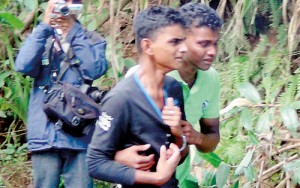
The killings continued, with the murderer targeting older women in the area. By 2012, 15 women had been killed; the deaths included three double murders.
The victims have all been older women who lived alone or with another female family member. Records show that all of them were sexually assaulted and attacked with sharp weapons and buried near the banks of a canal or stream. Some of the bodies found were charred.
No arrests were made, and rumours abounded that a bhoothaya (evil spirit) was roaming the village, targeting women living alone. In 2013, frustrated Kahawatte residents launched a mass protest in a show of no-confidence in the police who seemingly had shown little interest in solving the crimes.
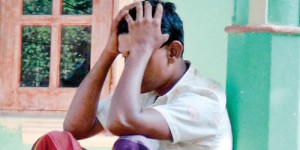
The victim’s husband. Pix by Lasantha Niroshana
Inspector-General of Police N.K. Illangakoon had to intervene and quell the locals’ fears.
He attributed the murders to property disputes among families and gave assurances that he would solve the murders quickly. Many residents, however, opted to move away. Those who remained had property or livelihood connected to the area.
In January 2014, 31 police officers from Kahawatte were transferred for inefficiency in solving the spate of crimes.
Soon afterwards, a United People’s Freedom Alliance (UPFA) member of the Godakawela Pradeshaya Sabha, Lokugumhewege Dharmasri and three others were arrested for the double murder of Nayananma Nilmini, 52, and her 19-year-old daughter, Kavinda
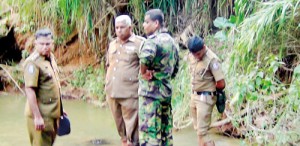
Police and army personnel at the stream where the body was found
Chatrangi on 2 February, 2012.
Police later pinned 14 of the 15 murders on the suspects. They were, however, released on bail due to lack of evidence to indict them.
Months afterwards, the chief suspect, Abhaya Priyantha, was abducted by an armed gang and murdered. To add to the horrors, the chief witness in the case died after consuming poison.
The police on Friday claimed they had resolved all cases in Kotakathana and three nearby grama sevaka areas except for two cases. Residents, however, have reservations.
The Senior Superintendent of Police in Ratnapura, Palitha Fernando, said there was no reason to connect last week’s murder with the serial murders committed since 2008. He claimed this was an isolated case.
A sociological study in Kahawatte area carried out by the Defence Ministry alongwith the Sociology Department of Sri Jaywardenapura in 2012 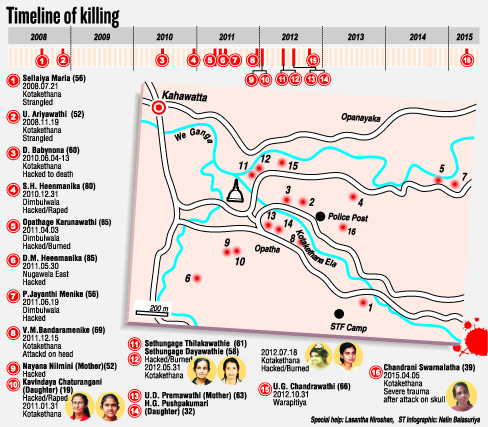 showed the people of Kotakethana suffer social neglect.
showed the people of Kotakethana suffer social neglect.
The report points to a lack of basic needs in education and infrastructure. Only a 1.5km path linked the villagers to the major community centres of Kahawatte and Ratnapura.
Lack of schools, access to health or places of worship have led to a deterioration in Kotakethana’s social structure, the report states.
“This has enabled politicians to take the law into their own hands,” said Prof. Mayura Samarakone, who worked on the survey.
Kahawatte Government Agent Sunil Kannangara said local officials were working on many of the recommendations in the survey with a range of government officials and women’s and youth groups.
Counsellors are working to help rid the local population of its fear psychosis, Mr. Kannangara said. “It is an ongoing process,” he added.
Last week’s killing, however, raises the question as to whether the problem in Kotakethana could be attributed to the under-development of the village. It could be argued that many villages in the North-Central Province and even in the formerly war-torn Northern and Eastern Provinces function with minimum or no basic facilities – but without the terror of serial killings.

